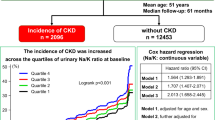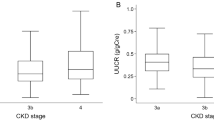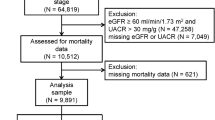Abstract
A higher urinary sodium-to-potassium (UNa/K) ratio has been reported to be associated with high blood pressure and subsequent cardiovascular events. However, the association between the UNa/K ratio and renal outcomes remains uncertain. We prospectively investigated the association between the UNa/K ratio and renal outcomes in patients with chronic kidney disease (CKD). We enrolled 716 patients with CKD, and 24-h urinary sodium and potassium excretion were measured. Patients were divided into UNa/K ratio tertiles (T1–T3). Endpoints were defined as a composite of doubling of serum creatinine (SCr), end-stage kidney disease (ESKD), or death and a composite of doubling of SCr or ESKD (added as an alternative outcome). We investigated the association between the UNa/K ratio and renal outcomes using a Cox proportional hazards model. During a median follow-up of 2.3 years, doubling of SCr, ESKD, or death and doubling of SCr or ESKD occurred in 332 and 293 patients, respectively. After adjustment for covariates including potentially confounding variables such as plasma renin activity, plasma aldosterone concentration, and B-type natriuretic peptide, the hazard ratios (HRs) (95% confidence intervals [CIs]) for the composite of doubling of SCr, ESKD, or death for T2 and T3 were 1.44 (1.06–1.96) and 1.59 (1.14–2.21), respectively, compared with T1. Additionally, compared with T1, the highest tertile (T3) of the UNa/K ratio was associated with a composite of doubling of SCr or ESKD (HR 1.55, 95% CI 1.09–2.20). A higher UNa/K ratio was independently associated with poor renal outcomes in patients with CKD.
This is a preview of subscription content, access via your institution
Access options
Subscribe to this journal
Receive 12 print issues and online access
$259.00 per year
only $21.58 per issue
Buy this article
- Purchase on Springer Link
- Instant access to full article PDF
Prices may be subject to local taxes which are calculated during checkout

Similar content being viewed by others
References
Aaron KJ, Sanders PW. Role of dietary salt and potassium intake in cardiovascular health and disease: a review of the evidence. Mayo Clin Proc. 2013;88:987–95.
Iwahori T, Miura K, Ueshima H, Tanaka-Mizuno S, Chan Q, Arima H, et al. Urinary sodium-to-potassium ratio and intake of sodium and potassium among men and women from multiethnic general populations: the INTERSALT Study. Hypertens Res. 2019;42:1590–98.
The Ministry of Health, Labour, and Welfare. The results of the 2019 National Health and Nutrition Survey in Japan. Accessed on 21 Feb 2021. https://www.mhlw.go.jp/content/10900000/000687163.pdf.
Intersalt Cooperative Research Group. Intersalt: an international study of electrolyte excretion and blood pressure. Results for 24h urinary sodium and potassium excretion. BMJ. 1988;297:319–28.
Perez V, Chang ET. Sodium-to-potassium ratio and blood pressure, hypertension, and related factors. Adv Nutr. 2014;5:712–41.
Hedayati SS, Minhajuddin AT, Ijaz A, Moe OW, Elsayed EF, Reilly RF, et al. Association of urinary sodium/potassium ratio with blood pressure: sex and racial differences. Clin J Am Soc Nephrol. 2012;7:315–22.
Averill MM, Young RL, Wood AC, Kurlak EO, Kramer H, Steffen L, et al. Spot urine sodium-to-potassium ratio is a predictor of stroke. Stroke. 2019;50:321–7.
Cook NR, Obarzanek E, Cutler JA, Buring JE, Rexrode KM, Kumanyika SK, et al. Joint effects of sodium and potassium intake on subsequent cardiovascular disease: the Trials of Hypertension Prevention follow-up study. Arch Intern Med. 2009;169:32–40.
Hattori H, Hirata A, Kubo S, Nishida Y, Nozawa M, Kawamura K, et al. Estimated 24 h urinary sodium-to-potassium ratio is related to renal function decline: A 6-year cohort study of Japanese urban residents. Int J Environ Res Public Health. 2020;17:5811.
Deriaz D, Guessous I, Vollenweider P, Devuyst O, Burnier M, Bochud M, et al. Estimated 24-h urinary sodium and sodium-to-potassium ratio are predictors of kidney function decline in a population-based study. J Hypertens. 2019;37:1853–60.
Tabara Y, Takahashi Y, Setoh K, Kawaguchi T, Kosugi S, Nakayama T, et al. Prognostic significance of spot urine Na/K for longitudinal changes in blood pressure and renal function: The Nagahama Study. Am J Hypertens. 2017;30:899–906.
Koo H, Hwang S, Kim TH, Kang SW, Oh KH, Ahn C, et al. The ratio of urinary sodium and potassium and chronic kidney disease progression: results from the KoreaN Cohort Study for Outcomes in Patients with Chronic Kidney Disease (KNOW-CKD). Medicine. 2018;97:e12820.
Graudal NA, Hubeck-Graudal T, Jurgens G. Effects of low sodium diet versus high sodium diet on blood pressure, renin, aldosterone, catecholamines, cholesterol, and triglyceride. Cochrane Database Syst Rev. 2020;12:CD004022.
Shimosawa T. Salt, the renin-angiotensin-aldosterone system and resistant hypertension. Hypertens Res. 2013;36:657–60.
McDonough AA, Veiras LC, Guevara CA, Ralph DL. Cardiovascular benefits associated with higher dietary K+ vs. lower dietary Na+: evidence from population and mechanistic studies. Am J Physiol Endocrinol Metab. 2017;312:E348–E56.
Clase CM, Carrero JJ, Ellison DH, Grams ME, Hemmelgarn BR, Jardine MJ, et al. Potassium homeostasis and management of dyskalemia in kidney diseases: conclusions from a Kidney Disease: Improving Global Outcomes (KDIGO) Controversies Conference. Kidney Int. 2020;97:42–61.
Kieneker LM, Gansevoort RT, Mukamal KJ, de Boer RA, Navis G, Bakker SJ, et al. Urinary potassium excretion and risk of developing hypertension: the prevention of renal and vascular end-stage disease study. Hypertension. 2014;64:769–76.
Okamoto R, Ali Y, Hashizume R, Suzuki N, Ito M. BNP as a major player in the heart-kidney connection. Int J Mol Sci. 2019;20:3581.
Yoshitomi R, Nakayama M, Sakoh T, Fukui A, Shikuwa Y, Tominaga M, et al. Plasma B-type natriuretic peptide concentration is independently associated with kidney function decline in Japanese patients with chronic kidney disease. J Hypertens. 2016;34:753–61.
Terata S, Kikuya M, Satoh M, Ohkubo T, Hashimoto T, Hara A, et al. Plasma renin activity and the aldosterone-to-renin ratio are associated with the development of chronic kidney disease: the Ohasama Study. J Hypertens. 2012;30:1632–8.
Castañeda-Bueno M, Arroyo JP, Gamba G. Independent regulation of Na+ and K+ balance by the kidney. Med Princ Pract. 2012;21:101–14.
Ku E, McCulloch CE, Vittinghoff E, Lin F, Johansen KL. Use of antihypertensive agents and association with risk of adverse outcomes in chronic kidney disease: focus on angiotensin-converting enzyme inhibitors and angiotensin receptor blockers. J Am Heart Assoc. 2018;7:e009992.
He J, Mills KT, Appel LJ, Yang W, Chen J, Lee BT, et al. Urinary sodium and potassium excretion and CKD progression. J Am Soc Nephrol. 2016;27:1202–12.
Japanese Society of Nephrology. Evidence-based practice guideline for the treatment of CKD. Nihon Jinzo Gakkai Shi. 2018;60:1037–193.
Japanese Society of Nephrology: Clinical practice guidebook for diagnosis and treatment of chronic kidney disease. Chapter 17. Modification of lifestyle and diet. Clin Exp Nephrol. 2009;13:228–30.
Matsuo S, Imai E, Horio M, Yasuda Y, Tomita K, Nitta K, et al. Revised equations for estimated GFR from serum creatinine in Japan. Am J Kidney Dis. 2009;53:982–92.
O’Donnell M, Mente A, Rangarajan S, McQueen MJ, Wang X, Liu L, et al. Urinary sodium and potassium excretion, mortality, and cardiovascular events. N. Engl J Med. 2014;371:612–23.
Mente A, O’Donnell M, Rangarajan S, McQueen M, Dagenais G, Wielgosz A,x et al. Urinary sodium excretion, blood pressure, cardiovascular disease, and mortality: a community-level prospective epidemiological cohort study. Lancet. 2018;392:496–506.
Fan L, Tighiouart H, Levey AS, Beck GJ, Sarnak MJ. Urinary sodium excretion and kidney failure in nondiabetic chronic kidney disease. Kidney Int. 2014;86:582–8.
Smyth A, Dunkler D, Gao P, Teo KK, Yusuf S, O’Donnell MJ, et al. The relationship between estimated sodium and potassium excretion and subsequent renal outcomes. Kidney Int. 2014;86:1205–12.
Kieneker LM, Bakker SJ, de Boer RA, Navis GJ, Gansevoort RT, Joosten MM. Low potassium excretion but not high sodium excretion is associated with increased risk of developing chronic kidney disease. Kidney Int. 2016;90:888–96.
Araki S, Haneda M, Koya D, Kondo K, Tanaka S, Arima H, et al. Urinary potassium excretion and renal and cardiovascular complications in patients with type 2 diabetes and normal renal function. Clin J Am Soc Nephrol. 2015;10:2152–8.
Kim HW, Park JT, Yoo TH, Lee J, Chung W, Lee KB, et al. Urinary potassium excretion and progression of CKD. Clin J Am Soc Nephrol. 2019;14:330–40.
Leonberg-Yoo AK, Tighiouart H, Levey AS, Beck GJ, Sarnak MJ. Urine potassium excretion, kidney failure, and mortality in CKD. Am J Kidney Dis. 2017;69:341–9.
Fox CS, Larson MG, Hwang SJ, Leip EP, Rifai N, Levy D, et al. Cross-sectional relations of serum aldosterone and urine sodium excretion to urinary albumin excretion in a community-based sample. Kidney Int. 2006;69:2064–9.
Fukui A, Nakayama M, Tanaka S, Matsukuma Y, Yoshitomi R, Nakano T, et al. Association between urinary salt excretion and albuminuria in Japanese patients with chronic kidney disease: the Fukuoka kidney disease registry study. Clin Exp Nephrol. 2021;25:9–18.
Roscioni SS, Lambers Heerspink HJ, de Zeeuw D. Microalbuminuria: target for renoprotective therapy PRO. Kidney Int. 2014;86:40–9.
Fujiwara N, Osanai T, Kamada T, Katoh T, Takahashi K, Okumura K. Study on the relationship between plasma nitrite and nitrate level and salt sensitivity in human hypertension: modulation of nitric oxide synthesis by salt intake. Circulation. 2000;101:856–61.
He FJ, Marciniak M, Carney C, Markandu ND, Anand V, Fraser WD, et al. Effects of potassium chloride and potassium bicarbonate on endothelial function, cardiovascular risk factors, and bone turnover in mild hypertensives. Hypertension. 2010;55:681–8.
Adrogué HJ, Madias NE. Sodium and potassium in the pathogenesis of hypertension. N. Engl J Med. 2007;356:1966–78.
Adrogué HJ, Madias NE. Shared primacy of sodium and potassium on cardiovascular risk. Am J Kidney Dis. 2009;54:598–601.
Bagrov AY, Shapiro JI. Endogenous digitalis: pathophysiologic roles and therapeutic applications. Nat Clin Pr Nephrol. 2008;4:378–92.
Fujita T, Ito Y. Salt loads attenuate potassium-induced vasodilation of forearm vasculature in humans. Hypertension. 1993;21:772–8.
Okuyama Y, Uchida HA, Iwahori T, Segawa H, Kato A, Takeuchi H, et al. The relationship between repeated measurement of casual and 24-h urinary sodium-to-potassium ratio in patients with chronic kidney disease. J Hum Hypertens. 2019;33:286–97.
World Health Organization. WHO Guideline: sodium intake for adults and children. Geneva: World Health Organization, 2012. Accessed 20 Feb 2021. http://www.who.int/nutrition/publications/guidelines/sodium_intake/en/.
World Health Organization. Guideline: Potassium Intake for Adults and Children. Geneva: World Health Organization, 2012. Accessed 20 Feb 2021. https://www.who.int/nutrition/publications/guidelines/potassium_intake/en/.
Iwahori T, Miura K, Ueshima H. Time to consider use of the sodium-to-potassium ratio for practical sodium reduction and potassium increase. Nutrients. 2017;9:700.
Mathialahan T, Maclennan KA, Sandle LN, Verbeke C, Sandle GI. Enhanced large intestinal potassium permeability in end-stage renal disease. J Pathol. 2005;206:46–51.
Ueda Y, Ookawara S, Ito K, Miyazawa H, Kaku Y, Hoshino T, et al. Changes in urinary potassium excretion in patients with chronic kidney disease. Kidney Res Clin Pract. 2016;35:78–83.
Weir MR, Rolfe M. Potassium homeostasis and renin-angiotensin-aldosterone system inhibitors. Clin J Am Soc Nephrol. 2010;5:531–48.
Acknowledgements
We would like to express our gratitude to the 716 participants of the study. We thank Richard Robins, PhD, from Edanz Group (https://en-author-services.edanz.com/ac) for editing a draft of this manuscript.
Author information
Authors and Affiliations
Corresponding author
Ethics declarations
Conflict of interest
The authors declare no competing interests.
Additional information
Publisher’s note Springer Nature remains neutral with regard to jurisdictional claims in published maps and institutional affiliations.
Supplementary information
Rights and permissions
About this article
Cite this article
Matsukuma, Y., Nakayama, M., Tsuda, S. et al. Association between the urinary sodium-to-potassium ratio and renal outcomes in patients with chronic kidney disease: a prospective cohort study. Hypertens Res 44, 1492–1504 (2021). https://doi.org/10.1038/s41440-021-00741-y
Received:
Revised:
Accepted:
Published:
Issue Date:
DOI: https://doi.org/10.1038/s41440-021-00741-y
Keywords
This article is cited by
-
Fluid homeostasis induced by sodium-glucose cotransporter 2 inhibitors: novel insight for better cardio-renal outcomes in chronic kidney disease
Hypertension Research (2023)
-
The eighth installment in Asian perspectives, salt, pregnancy, and masked hypertension
Hypertension Research (2022)



